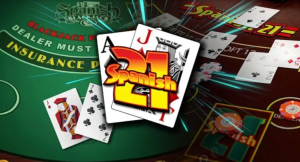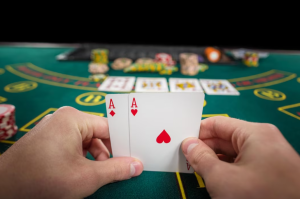Spanish 21 is a popular variant of the classic game of blackjack that offers players a different set of challenges and opportunities for winning. This guide will walk you through the essentials on how to win Spanish 21 using various strategies and tips.
Understanding the Basics
Before diving into the Spanish 21 strategy, it’s crucial to understand the game’s fundamentals. Spanish 21 is usually played with six to eight decks of cards, each containing 48 cards (all 10s are removed). It has specific rules that differ from traditional blackjack, such as allowing late surrender and re-splitting Aces.
How Do You Play Spanish 21?
To start playing, each player and the dealer are dealt two cards. The objective remains to have a hand value closest to 21 without going over, while still beating the dealer’s hand.

In Spanish 21, after the initial deal of two cards, players have various options to enhance their hand. They can choose to “hit” to receive additional cards, aiming to improve their hand value. Alternatively, they can “stand” if they are satisfied with their current hand. Another intriguing feature is the option to “double down,” which allows players to double their initial bet in exchange for committing to stand after receiving one more card.
Furthermore, Spanish 21 introduces the exciting possibility of “surrender.” If a player believes their hand has little chance of winning, they can opt to surrender and forfeit half of their bet, saving the other half.
The game also includes bonus payouts for specific combinations, such as 21-point hands made up of certain card combinations, adding an extra layer of excitement to this dynamic card game.
Key Elements in Spanish 21 Strategy
Spanish 21 Basic Strategy
If you’re a beginner, start with a Spanish 21 basic strategy chart. This chart will guide you through whether to hit, stand, double, or split based on your hand and the dealer’s face-up card.
Using a Spanish 21 basic strategy chart is an excellent way for beginners to get acquainted with the game’s optimal decision-making process. It provides a clear roadmap for players, helping them make informed choices in each situation they encounter at the blackjack table. Over time, as players become more comfortable and experienced, they can adapt their strategies to suit their individual playing style and preferences. However, mastering the basics with the aid of a strategy chart is an essential first step towards becoming a skilled Spanish 21 player.
Spanish 21 Strategy Card
A Spanish 21 strategy card is a portable version of the basic strategy chart, handy for quick references while playing.
Spanish 21 Trainer
Invest time in using a Spanish 21 trainer. These are software or apps that simulate the game, allowing you to practice your strategies under realistic conditions.
Advanced Tips and Techniques
Doubling and Splitting
If the rules and your hand allow, doubling and splitting can significantly improve your Spanish 21 odds. Usually, doubling is favorable when you have a hard 9, 10, or 11.
When it comes to doubling in Spanish 21, it’s important to consider the dealer’s face-up card as well. If the dealer’s card is weak, such as a 5 or 6, it’s often a good opportunity to double down and aim for a higher hand value. However, with hard totals like 12 or higher, it’s generally not advisable to double, as the risk of busting is higher. Splitting, on the other hand, can be a strategic move when you have pairs, especially against a dealer’s weak card. It can potentially lead to two winning hands instead of one, maximizing your chances of success in the game.
Late Surrender
One unique feature of Spanish 21 is the option for late surrender. This option allows you to cut losses when you have a weak hand compared to the dealer’s strong hand.
How to Beat Spanish 21: Tactical Insights
Counting Cards
Although harder due to the missing 10s, counting cards can still be a viable Spanish blackjack strategy. It may not be as effective as in traditional blackjack, but it does provide a slight edge.
Counting cards in Spanish 21 involves keeping track of the number of high and low-value cards left in the deck. Since Spanish 21 uses decks without the 10s, you’ll focus on tracking other cards to estimate the likelihood of drawing favorable hands. While it requires practice and skill, proficient card counting can give you an advantage by making informed bets and decisions based on the composition of the remaining cards. Just remember that casinos closely monitor card counters, so discretion is key to using this strategy effectively.

The Rule of 21
A golden rule in how to win at Spanish 21 is always to aim for 21. This game offers bonuses for a five-card 21, a six-card 21, and a 21 consisting of 7-7-7, providing more chances to win.
Additional Resources
Spanish 21 Chart
A Spanish 21 chart outlines all possible hand combinations and tells you the best move for each. You can find these online or in strategy books.
Basic Strategy for Spanish 21
While there is a basic strategy for Spanish 21, it’s vital to adapt and adjust based on the specific rules of the table you’re playing at.
Spanish 21 Tips
Some additional Spanish 21 tips include always checking the paytable, as different casinos offer various payouts for specific hands. Also, aim for tables that pay 3:2 rather than 6:5 for a natural blackjack.
Additionally, when playing Spanish 21, it’s essential to take advantage of any bonus payouts the casino may offer. These can vary but often include extra rewards for specific combinations or side bets. Furthermore, practice and familiarity with the game’s nuances are key to success. By honing your skills and understanding the intricacies of Spanish 21, you can improve your odds and make more strategic decisions during the game.
Wrapping Up: Increasing Your Odds
Understanding the basic strategy Spanish 21 offers and employing advanced tactics can increase your odds significantly. Learning how to play Spanish 21 is not merely about following a chart but adapting your strategy according to the game flow.
In the quest to how to win Spanish 21, arm yourself with a strategy card, practice using a trainer, and never underestimate the power of understanding the odds. With the right approach, Spanish 21 can be both an enjoyable and rewarding experience.


